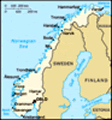Advertisement
Published: June 26th 2017
Geo: 60.3881, 5.33185
The Nordkapp docked at Bergen on Wednesday afternoon about 2-30pm We were off quickly and a short taxi ride took us to our hotel, Hotel Augustin. This is an historic hotel, right near the harbour front and it is the place that Amunsden stayed at before his North Pole expedition. We have a fantastic room on the corner with windows on three sides and views across to the Cruise ship dock and Bryggen.
Having checked in it was off for a stroll around the town. We walked along the harbour front to the Fish Market. Here were plenty of stalls stacked with all kinds of fish, Monkfish, salmon,trout lobsters, mussels etc etc. Nearby were cafes willing to prepare the fresh fish you have just bought. At the head of the harbour were more stalls selling souvenirs including beautiful hand knitted traditional patterned jumpers, gloves, socks etc. Again plenty of restaurants and bars and lots of tourists.
The best part though is Bryggen, a UNESCO World Heritage Site, which contains the row of warehouses once belonging to the Hanseatic League who ran this town in the 17th century. The brightly painted buildings now house souvenir shops and cafes but they are

 Augustin Hotel
Augustin Hotel
Our wroom is the window just above the scaffoldingwell maintained and present a wonderful facade. At the end of this side of the harbour is the Fortress guarding the entrance. The two oldest buildings here are Haakon's Hall which is under renovation and Rosenkrantz Tower. Both were originally built in the 1500s. They were extensively damaged in 1944 when a German ammunition boat blew up right in front of them but have now been restored. Looked hard but I couldn't see any sign of Guildenstern!!
We explored further into Bryggen by going down one of the small lanes. Here we came across a white stone building from 1666. This is the oldest house in Bergen as most were burnt down in a devastating fire in 1702. There was a wooden statue of what looks like an emaciated fish nearby. We worked out later that this is dried cod on which the fortunes of Bergen, and in fact Norway, were built. We walked back to a cafe to stop for a beer. They don't seem to do cold beer here. If it is out of a can it is usually just tepid.
We walked up another interesting side street and found ourselves opposite Kvorskirke bearing the date 1705. Further up the
street was Domskirke with the same date. Obviously these had been built after the fire. These are both built in grey stone with copper spires. We then walked back towards the harbour and came into another large square with several souvenir stores. Our final stop was in the more modern mall area where there is a large monument depicting Bergen's history. Quite impressive.
That night we had dinner in the hotel's restaurant, Altona, which is situated in a 400 year old cellar. They boast the best wine list in Norway and it fills about 20 pages. Here we had a great dinner starting with an entree of King Crab, beautifully cooked and presented, then Fletcher had plaice and I had veal. The two thick veal steaks were tender and delicious but a huge serve. We accompanied this with a smooth French Pouilly-Fumee which went down very well. A pleasant evening.
On Thursday we returned to Bryggen to check out some of the museums. We first went into the Hanseatic League Museum. This was the original headquarters and administration building which has been kept as it was in the 1600s. The small rooms contained offices and bedrooms where the clerks who did the
paper work lived and worked. It was interesting to read about this powerful organisation which originated in Germany and spread its trade tentacles throughout Europe.
We then went down to the fortress. I had to go into the Rosenkrantz Tower. Fletcher took one look at the narrow winding staircases and decided to wait for me outside. This tower had been built by Erik Rosenkrantz in the 1560s when he was the governor of Bergen Castle. It is based on Scottish towers. It has an imposing Renaissance facade and there are several grand rooms on various levels. The main Hall is large and Rosenkrantz's own private room has beautiful windows and a relief of he and his wife on the wall. The stairs were very narrow and winding but I enjoyed exploring there.
We then walked through the gardens of the fortress which were very attractive and surprisingly peaceful. Our last stop here was the Fortress Museum. This was free and contained various rooms showing the history of Begen from a military perspective. The top floor contained uniforms and models of the fortress over the years but the most interesting section dealt with the Norwegian Resistance to German Occupation in WW2. This
was quite similar to the story we saw in Amsterdam as the same moral questions were faced by those who stayed in their administrative posts in spite of German Occupation. There was also quite a display about the underground resistancel newspapers which were maintained throughout this time.
By this time it was time for lunch which we had in the Harbour Cafe before returning to the hotel for a rest. Fletcher couldn't walk too much more. We stayed there for the rest of the afternoon venturing out to eat dinner at the Chinese Palace. We had had enough of fish for the time being. Unfortunately this was a Norwegian version of Chinese with the food being quite bland or over sweet and the Szcheuan salty but little spice. C'est la Vie!
Advertisement
Tot: 0.081s; Tpl: 0.016s; cc: 7; qc: 24; dbt: 0.0553s; 1; m:domysql w:travelblog (10.17.0.13); sld: 2;
; mem: 1.1mb














